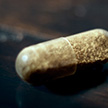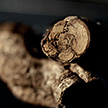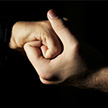History
The relationship between the human species and plants capable of altering body and mind is millenarian; people have developed a harmonic relationship with these plants, and frequently they have had a great influence in the human and cultural development of many societies and civilizations.
In Central West Africa grows a plant called Tabernanthe iboga the root bark of which has played a major role in rites of passage and healing ceremonies. The plant is used in Cameroon, Equatorial Guinea, Congo and, most notably, in Gabon by the Pygmees, Fang and Mitsogo tribes in a culture called Bwiti.
Ibogaine in modern society
In 1963, Howard Lotsof, a young heroin addict, undertook an experiment along with six fellow addicts, ingesting one of the twelve alkaloids found in the iboga root bark called ibogaine. The next day, six out of seven subjects stopped their heroin use, having no withdrawal or craving. In the following years, efforts to get ibogaine developed as an accepted treatment modality got little response from the pharmaceutical industry. NIDA composed a 4000 page Drug Master File with 16 volumes of pre-clinical studies. In 1993, the FDA approved a phase 1 clinical trial, which ended with the first patient due to conflicts about patents. In 1995, NIDA decided not to support ibogaine research anymore, but drug user unions and activist organizations promoted its use and made it available in non-clinical, underground contexts. The amount of treatment providers and demand by drug addicts has grown exponentially in the last 10 years. There are ibogaine clinics in countries including Brazil, Mexico, Canada, Thailand and South Africa, and lay treatment providers around the world. In 2009, New Zealand was the first country in the world to accept ibogaine as a prescription medication.
Use
Traditionally in the Bwiti culture, iboga is not used for drug dependency. It is used in rites of passage of adolescent boys or healing rites for men and women. In the span of five days, a death-rebirth process is initiated with the ingestion of this ethnobotanical and carefully guided by the community in the form of various rituals in which many people take part; a symbolic death of the adolescent or the ill gives way for the birth of the adult or the healed.
In Occidental society, ibogaine is an experimental tool in psychotherapy and addiction treatment used for opiate detoxification and addiction interruption of a variety of drugs and prescription medications. Despite the limited amount of animal studies, there is a growing body of animal studies, case reports and testimonials from addicts that underwent this treatment, which support the claims about its potential as a tool for the treatment of addiction.
Effects
Ibogaine itself has a very low abuse potential. Detoxification from opioids with a single large dose of ibogaine has been consistently observed in humans and corresponds to a large body of animal work. Treatment with ibogaine is followed by a period of variable duration of reduced craving for multiple substances including opiates, stimulants, alcohol, benzodiazepines and nicotine. Small booster doses or a second treatment some months later can increase the chance of long term abstinence.
Mechanisms of action
The mechanisms of action of ibogaine are not known. It does not act as an opioid agonist substitution therapy such as methadone. Individuals treated with adequate single doses of ibogaine do not go back into acute withdrawal following treatment, and doses of ibogaine used in detoxification do not produce opioid overdose in individuals who lack tolerance to opioids. The reduction of post-treatment drug craving has been suggested to be related to the increased expression of glial cell-line derived neurotropic factor (GDNF), a protein produced by the body that supports the growth and survival of dopaminergic neurons that are thought to play a role in addiction. This and other evidence indicates that ibogaine produces long-lasting changes in cell signaling pathways related to addiction.
Because the mechanism of action of ibogaine is novel, it promises to bring new understanding of the neurobiology of addiction and the development of fundamentally innovative treatment.
The experience
Ibogaine also induces an introspective experience which is frequently reported as being profoundly psychotherapeutic. It is being referred to as ‘oneiric’ because it often induces dream-like visions, although this is not always the case. The ibogaine experience is not a hallucinogenic experience as the individual is always aware of where she is, that the experience is caused by the ingestion of the ibogaine, and that the visions that one has during the experience are internal projections.
The initial phase of the experience is a 7-12 hour intense visual introspection, highly charged with information, but without much emotional connection with the individual or psychological integration of the contents during this phase. In the next 24 hours of the experience, the visionary phase wears off and the contents of this process are integrated in a cognitive process. Afterwards this integration process continues in daily life for months in which the individual re-defines his/her identity and interpersonal dynamics in his/her environment post-ibogaine.
The complexity of addiction
Although ibogaine is a very potent addiction interrupter, it is not a wonder drug that ‘cures’ addiction, as it’s been referred to extensively in the media. A complex multi-layered issue such as addiction needs to be addressed at all levels to achieve long term abstinence with a satisfying day to day living. Ibogaine should therefore be used in a therapeutic context which includes a proper psychological, physical and social preparation, a professional administration, adequate integration and a follow-up process involving psychotherapy, family therapy, group therapy, social assistance, etc.
Safety
Also important to take into account is that ibogaine has a series of risk factors: it lowers the heart rate and prolongs the QT interval of the EKG. People with pre-existing heart conditions such as vulnerability to heart attacks, arrhythmia or a naturally slow heart rate (e.g. sports heart) should thereby be excluded from this treatment option. Pulmonary embolism is a risk after blood clot formation in the veins (e.g. after long airplane travels). Ibogaine lowers the tolerance and potentiates the toxicity of stimulants, opiates and other drugs; this can be fatal and should therefore never be combined. Ibogaine should never be combined with certain foods or medications, such as those that are metabolized by the CYP2D6 enzymes (e.g. grapefruit, quinine, etc). The psychoactive effects can also cause complications in people with pre-existing mental illness, including personality disorders and psychosis. A proper psychiatric and physical screening, including stress ECG or 24 hour Holter monitor, a blood test (CBC) and a liver enzyme test (AST/ALT) are essential for a safe treatment. There are different materials being used, ranging from pulverized root bark to extracts, containing, aside from ibogaine, the other alkaloids found in the root bark, to pure ibogaineHCL of which the quality and composition can differ greatly. This can also be an additional risk factor.
Legal Status
Since the discovery of ibogaine’s anti-addictive properties in 1963, global acceptance of its therapeutic application and its development as an addiction interrupter medication has been very slow due to the fact ibogaine is a natural occurring molecule and therefore cannot be owned with a patent while it’s highly complex mechanisms of action are extremely expensive to fully research. Along with the fact that psychoactive compounds like ibogaine are stigmatized, as is the addiction patient population because of its high mortality rate. Ibogaine is not on the international lists of controlled psychotropic substances of the International Narcotics Control Board of the United Nations, but it is illegal in the US, Australia, Belgium, France, Switzerland, Sweden, Poland, Denmark and Hungary.
Disclaimer
ICEERS takes care to ensure that the information presented on this website is accurate at the time of its publication. However, over time new scientific and medical information becomes available, and laws and legal enforcement polices change. In addition, laws and legal enforcement policies governing the use of substances discussed on this website vary from jurisdiction to jurisdiction. The reader is advised to carefully consult appropriate sources for the most current information on scientific, medical, and legal issues. Material on this website is not intended to and should not be used as a substitute for personal consultation with knowledgeable physicians and attorneys.
The information on this website is offered for informational use only, and is not intended for use in diagnosing any disease or condition or prescribing any treatment whatsoever. The information on this website is not intended to encourage the use of ethnobotanicals. ICEERS specifically cautions against the use of ethnobotanicals in violation of the law, without appropriate professional guidance and monitoring, or without careful personal evaluation of potential risks and hazards. ICEERS specifically disclaims any liability, loss, injury, or damage incurred as a consequence, directly or indirectly, of the use and application of any of the contents of this website.




